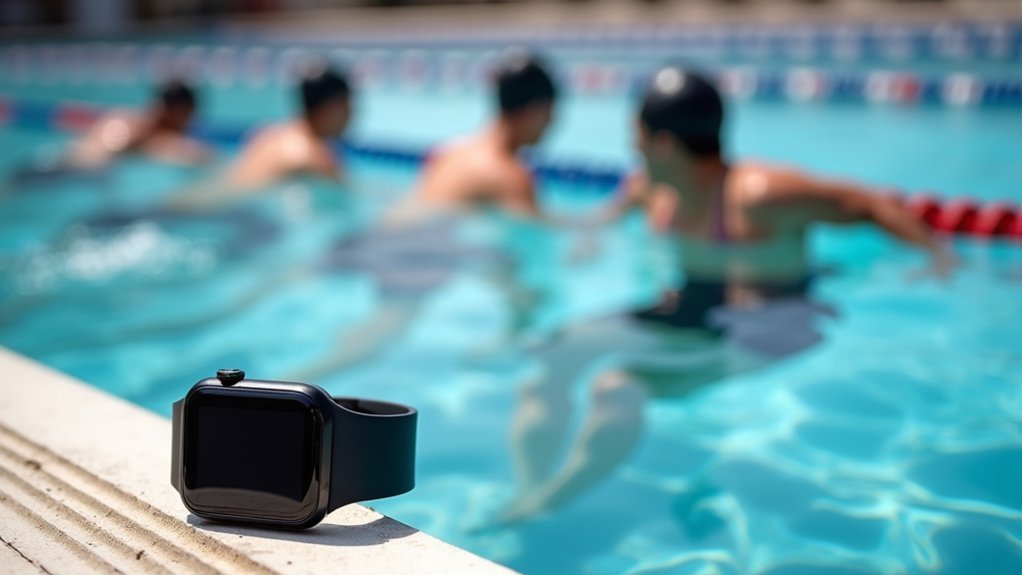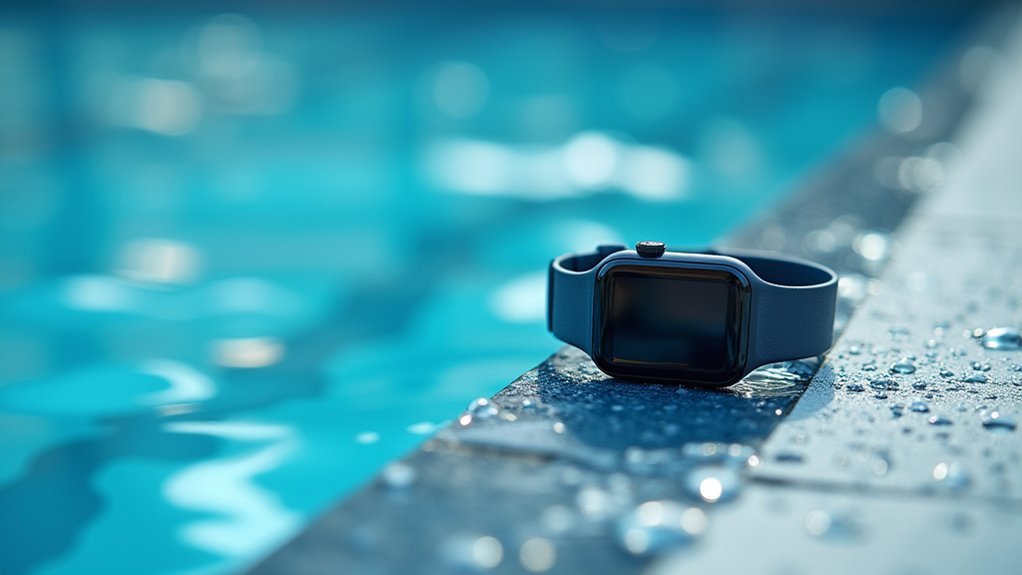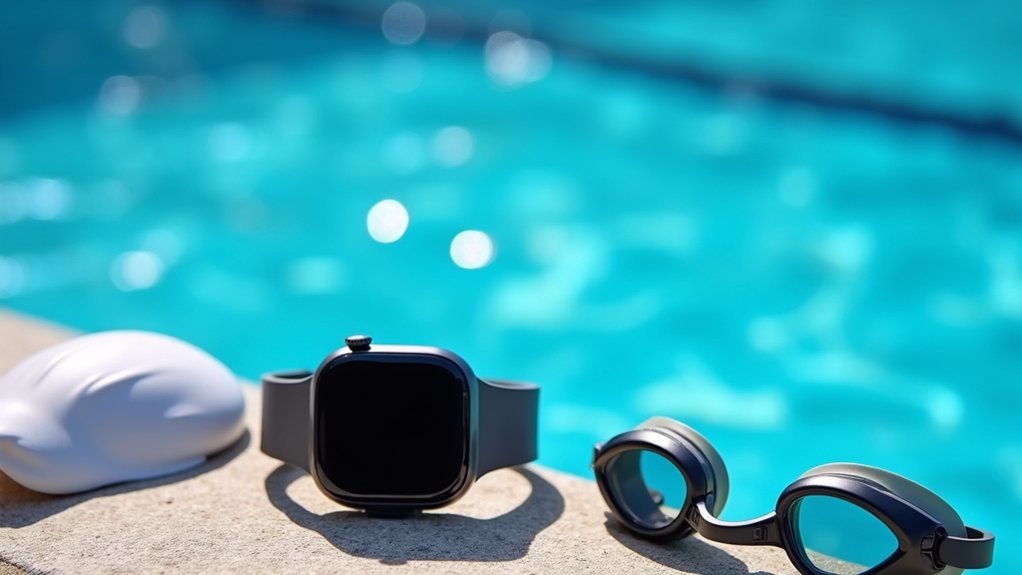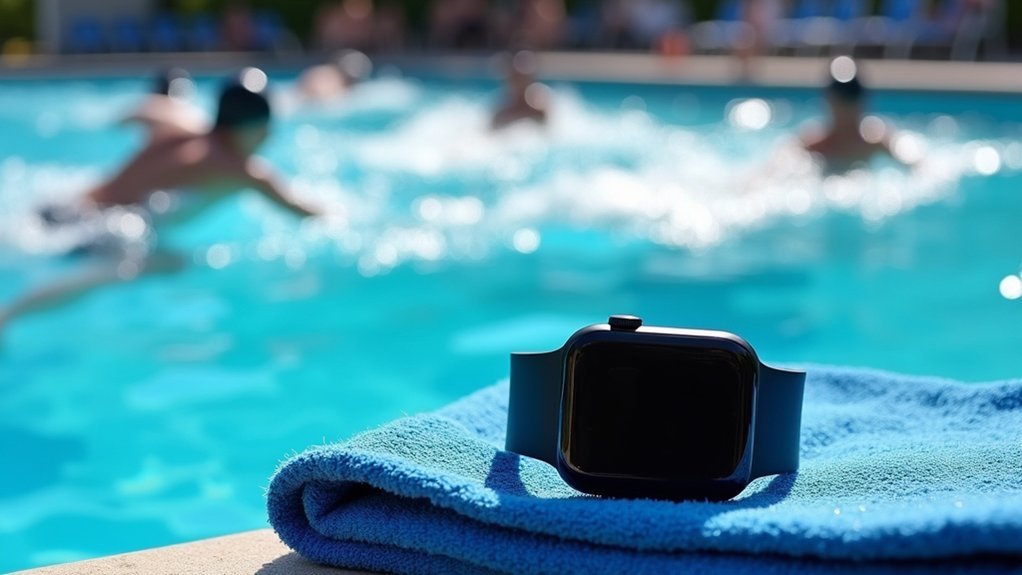For competitive swimming, you’ll need IPX7-rated electronics as your minimum standard. This rating protects devices during submersion up to one meter for 30 minutes, which covers typical training depths of 3-4 feet and exceeds most swim intervals. While IPX8 offers superior protection for deeper activities, IPX7 provides the ideal balance between waterproof capability and cost-effectiveness for pool training. Lower ratings like IPX4-6 risk device failure during actual swimming sessions. Understanding these standards helps you make informed equipment choices.
Understanding IPX Water Protection Standards for Swimming Equipment

When you’re selecting swimming equipment as a competitive swimmer, understanding IPX water protection standards becomes crucial for making informed decisions about gear that’ll withstand intense aquatic environments.
IPX ratings are part of the Ingress Protection system that measures water resistance in electronic products. Higher numbers indicate greater protection levels, with each rating designed for specific water exposure scenarios.
IPX ratings systematically classify water resistance levels in electronics, with higher numerical values indicating superior protection against specific aquatic exposure conditions.
You’ll find that IPX4 provides splash protection but isn’t suitable for submersion. IPX7 offers waterproofing up to 1 meter depth for 30 minutes, making it adequate for surface swimming.
However, IPX8 delivers the highest water resistance rating, allowing complete submersion beyond 1 meter. It’s essential to recognize that IPX ratings don’t include dust protection unless specified as IP68, which combines both water and dust resistance for thorough protection.
Understanding these ratings helps you avoid vague terminology like “waterproof” that manufacturers often use without providing specific protection details.
Pool Environment Challenges for Electronic Devices
Although your electronic swimming devices might boast impressive IPX ratings, they’ll face unique environmental challenges that extend far beyond basic water resistance when you’re training or competing in pool facilities.
You’ll encounter electrical systems throughout the pool area that increase shock risks, making GFCI protection and proper outlet placement critical for your devices’ safe operation.
Indoor pools present additional hurdles with poor air quality and high humidity levels that can compromise electronic components over time.
Water temperature fluctuations between 25°C to 28°C affect device performance, while wave generation from other swimmers creates unpredictable water movements.
These combined environmental factors mean you’ll need devices that exceed basic waterproofing standards to maintain reliable functionality during training sessions. Look for equipment with certified safety marks to ensure your devices have undergone rigorous testing for pool-specific conditions.
IPX4 Vs IPX7 Vs IPX8: Which Rating Matches Swimming Needs

When you’re choosing waterproof gear for competitive swimming, you’ll quickly encounter three main IPX ratings that seem suitable for aquatic use.
IPX4’s splash protection won’t cut it for actual swimming since it can’t handle immersion, leaving you with the choice between IPX7 and IPX8 ratings.
Understanding how IPX7’s limited submersion capabilities compare to IPX8’s continuous underwater performance will determine whether your devices survive intense training sessions. IPX8 offers the highest level of water protection in the IPX rating system.
IPX4 Splash Protection Limitations
While IPX4-rated devices offer reliable protection against splashes and sweat during dry-land training, they don’t provide adequate protection for competitive swimmers who regularly encounter full water immersion.
IPX4 rating only withstands water splashing from any direction for 10 minutes during testing. You’ll find this protection suitable for light rain, humid environments, and workout sweat, but it fails when water pressure increases or submersion occurs.
Moisture can enter through ports, buttons, or seams once you’re underwater. The IP code system was established by the International Electrotechnical Commission to provide clear standards for protection levels.
Key IPX4 limitations for swimmers include:
- No submersion protection – devices aren’t tested for static water immersion
- Pressure vulnerability – seals may fail under increased water pressure during swimming
- Limited exposure duration – not designed for prolonged or continuous water contact
You need IPX7 or IPX8 ratings for reliable underwater protection during competitive swimming.
IPX7 Versus IPX8 Performance
For competitive swimmers seeking reliable underwater protection, IPX7 and IPX8 ratings offer distinct performance capabilities that match different swimming requirements.
IPX7 provides protection against immersion up to 1 meter for 30 minutes, making it suitable for surface-level competitive swimming. However, you’ll find IPX8 delivers superior performance with continuous immersion protection beyond 1 meter, though specific conditions vary by manufacturer.
If you’re engaged in deeper water activities or need prolonged underwater exposure, IPX8’s continuous protection outperforms IPX7’s temporary immersion limits.
For competitive swimming at surface levels, IPX7 can suffice, but IPX8 offers more versatile protection for diverse swimming conditions. You should check manufacturer specifications for IPX8 devices to verify they meet your specific depth and duration requirements. These ratings follow the IEC 60529 standard which establishes the testing protocols for water ingress protection.
Why IPX7 Emerges as the Sweet Spot for Pool Training
Although higher IPX ratings exist, IPX7 strikes the perfect balance between protection and practicality for competitive swimmers.
When you’re training in the pool, you don’t need extreme depth protection—IPX7’s 1-meter resistance covers your swimming depth perfectly. The 30-minute submersion limit exceeds most training intervals, giving you reliable performance throughout your workout.
Here’s why IPX7 becomes your ideal training companion:
- Cost-effective solution – You’ll save money compared to higher-rated devices while getting adequate protection
- Simplified design focus – Manufacturers can concentrate on swimming-specific features rather than excessive water resistance
- Standard compliance assurance – You’re guaranteed recognized safety and performance criteria for pool use
IPX7 delivers exactly what competitive swimmers need without unnecessary complexity or cost, making it the sweet spot for serious pool training. The improved motivation and enhanced enjoyment during training sessions make this protection level even more valuable for maintaining consistent performance.
Electronic Swim Gear That Requires Waterproof Protection

Now that you understand the ideal IPX rating for pool training, you need to know which electronic devices actually require this waterproof protection.
You’ll primarily encounter five categories of swim gear that demand proper water resistance.
Waterproof headphones and music players top the list, as they’re directly exposed to water during your laps. You can’t rely on Bluetooth underwater, so these devices need onboard storage. Bone conduction models work best since they avoid audio distortion from water between earbuds and your eardrums.
Fitness trackers and smartwatches require protection while monitoring your heart rate, lap count, and swim metrics. Advanced models provide guided workouts and training plans specifically designed for swimmers.
Heart rate monitors with chest straps also need underwater engineering for competitive training.
Pool-integrated electronics like touchpads, timing systems, and underwater display systems demand waterproof components for accurate functionality and training feedback.
Submersion Depth and Duration Requirements for Competitive Swimming
Understanding the submersion requirements for competitive swimming directly impacts which IPX rating your electronic gear needs.
You’ll frequently swim 3 to 4 feet below the surface during underwater phases, where modern techniques like butterfly kicks enhance your speed. Competitive pools maintain depths of 6 feet or more to support these prolonged underwater sequences safely.
Your submersion duration varies by stroke and race strategy, but you’ll need gear that handles consistent water exposure at these depths.
Competitive swimmers require waterproof gear rated for consistent submersion at racing depths and extended underwater durations.
Pool depths less than 5 feet force earlier surfacing, impacting performance. Swimming areas must be inspected for safety, including water depth and clarity to ensure optimal conditions for competitive activities.
Key submersion factors affecting your gear choice:
- Depth exposure: Regular swimming at 3-4 feet below surface
- Duration requirements: Extended underwater phases during races
- Safety margins: Pools designed with 6+ foot depths for peak performance
IPX Rating Limitations That Swimmers Should Know

While IPX ratings provide valuable water protection guidance, they don’t tell the complete story about device durability in swimming environments.
You’ll notice IPX ratings only indicate water resistance—dust protection isn’t covered, leaving your device vulnerable to sandy poolside conditions.
Even with the same IPX8 rating, manufacturer specifications vary dramatically regarding maximum depth and submersion duration, so you must check specific guidelines.
Laboratory IPX tests don’t replicate real swimming conditions like dynamic movement, stroke impacts, or chlorine exposure that can compromise protection.
You should also verify that cables and charging ports maintain waterproof sealing, as these connection points often lack the same protection level as the main device body despite high IPX ratings.
Additionally, third-party testing organizations determine final IP ratings, which means the verification process occurs independently from manufacturers and provides standardized protection benchmarks.
Maintaining Water Resistance Performance in Chlorinated Pools
Although your device may boast an impressive IPX8 rating, chlorinated pool water presents unique challenges that can gradually compromise its water resistance performance.
Even waterproof devices with IPX8 ratings face gradual deterioration when exposed to chlorinated pool water over time.
Chlorine breaks down waterproofing materials over time, while pH imbalances accelerate this degradation process.
To maintain your device’s protective capabilities, you’ll need to establish a consistent maintenance routine:
- Clean thoroughly after each swim using mild soap to remove chlorine and chemical residues that build up on seals and gaskets
- Inspect waterproof seals regularly for signs of wear, cracking, or material degradation that could allow water penetration
- Store properly in dry conditions with adequate ventilation to prevent moisture buildup and material deterioration
Higher IP-rated devices like IPX8 withstand chlorinated environments better, but even premium waterproofing requires diligent care to preserve long-term performance. Remember that official IP ratings must be verified through testing by a certified, independent company to ensure genuine protection levels.
Selecting Reliable Waterproof Electronics for Training Sessions

When choosing electronics for competitive swimming training, you’ll need devices rated IPX7 or higher to handle the demanding aquatic environment. IPX7 protects against submersion up to 1 meter for 30 minutes, while IPX8 offers superior protection for deeper, longer underwater exposure during rigorous training sessions.
| IPX Rating | Water Protection Level |
|---|---|
| IPX4-IPX6 | Splash resistance only – inadequate for swimming |
| IPX7 | Submersion up to 1m/30min – minimum for competitive use |
| IPX8 | Extended deep submersion – ideal for intensive training |
| IPX9 | High-pressure jet protection – rarely needed for pools |
You should verify manufacturer testing standards and confirm devices resist chlorine exposure. Look for proper battery sealing and secure port covers. Always rinse equipment with fresh water after training to maintain waterproof performance. Remember that marketing terms can be misleading, as manufacturers often use vague language that complicates understanding of actual water resistance capabilities.
Cost-Benefit Analysis of Different IPX Ratings for Swimmers
Beyond selecting the right waterproof electronics, you’ll need to weigh the financial investment against performance benefits for each IPX rating level. Higher-rated devices cost more due to advanced sealing technology, but they’ll protect your investment better during intense training sessions.
IPX7 offers the sweet spot for most competitive swimmers—it handles full submersion up to one meter for thirty minutes while maintaining reasonable pricing. You’ll get reliable protection without breaking your budget.
IPX8 devices cost considerably more but suit swimmers who spend extensive time underwater or in open water conditions.
Consider these key cost factors:
- IPX5-6 devices cost less but risk failure during swimming
- IPX7 balances waterproof capability with affordability
- IPX8 commands premium pricing for continuous underwater use
Choose based on your specific training needs rather than over-specifying unnecessarily. Many waterproof devices achieve their protection through ultra-thin Parylene coatings that don’t add bulk or weight to your gear.
Frequently Asked Questions
Do IPX Ratings Affect Warranty Coverage for Swim Electronics Damaged by Water?
Yes, IPX ratings greatly affect warranty coverage. If you exceed your device’s rated water depth or immersion time limits, you’ll likely void your warranty. Manufacturers require strict adherence to IPX specifications for coverage.
Can Saltwater Swimming Require Different IPX Ratings Than Chlorinated Pool Swimming?
You’ll need the same IPX8 rating for both saltwater and chlorinated pools, but saltwater’s more corrosive nature requires better sealing materials and more frequent maintenance to preserve waterproof integrity.
How Often Should Ipx-Rated Device Seals Be Professionally Inspected or Replaced?
You should have IPX-rated device seals professionally inspected annually, or every six months with frequent water exposure. Replace seals every one to three years depending on usage intensity and environmental conditions.
Are There Specific IPX Testing Standards for Devices Used in Heated Pools?
Standard IPX testing doesn’t specifically address heated pool conditions. You’ll need devices with manufacturer specifications for temperature tolerance and chemical resistance beyond basic IPX ratings for reliable heated pool performance.
Do IPX Ratings Guarantee Protection Against Pool Chemicals Besides Chlorine Exposure?
No, IPX ratings don’t guarantee protection against pool chemicals like bromine or other disinfectants. You’ll need devices with specialized chemical-resistant materials and coatings, not just high water resistance ratings.
In Summary
You’ll find IPX7 offers the best balance for competitive swimming, protecting your electronics from pool splashes and temporary submersion without the premium cost of IPX8. Don’t rely on IPX4 for serious training—it won’t handle pool conditions. Remember that chlorine can degrade seals over time, so you’ll need to rinse and maintain your gear regularly. Choose reputable brands with proven track records in aquatic environments for reliable performance.





Leave a Reply